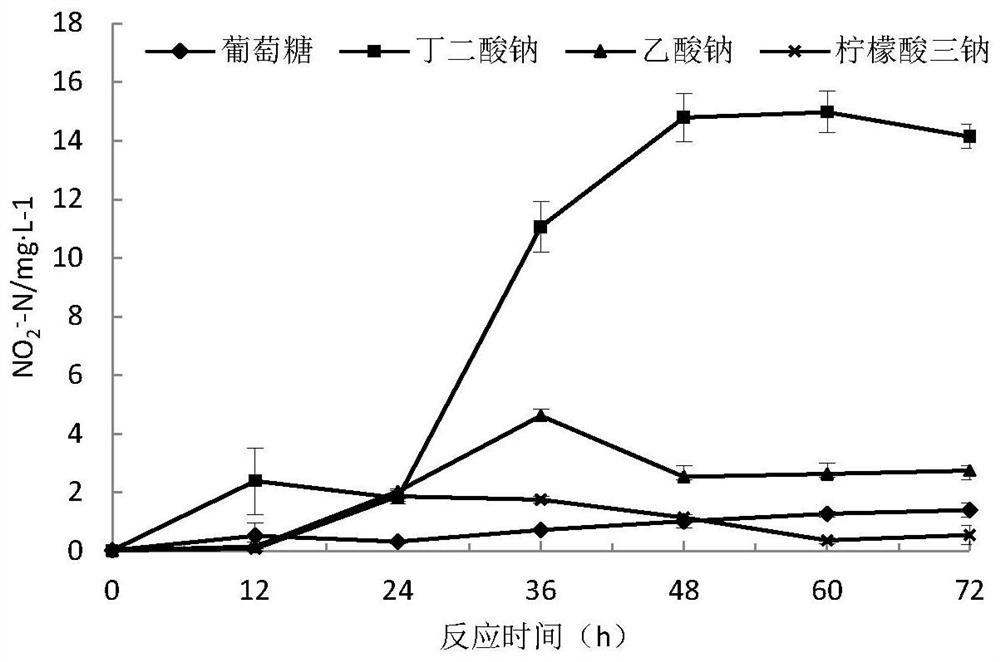Marine aerobic denitrifying halomonas and its application and method for treating aquaculture wastewater
A technology for aquaculture wastewater and Halomonas, applied in the field of microorganisms, can solve the problems of low denitrification efficiency, low denitrification efficiency, restricting the development of seawater pollution denitrification treatment technology and the like
- Summary
- Abstract
- Description
- Claims
- Application Information
AI Technical Summary
Problems solved by technology
Method used
Image
Examples
Embodiment 1
[0038] The separation and screening method of marine aerobic denitrifying halomonas described in embodiment 1:
[0039] 1. Experimental materials
[0040] 1. The source of the strain: the biological filter material in the primary biological filter of the pearl gentian grouper breeding workshop of Mingbo Aquatic Products Co., Ltd., Yantai City, Shandong Province.
[0041] 2. Culture medium and reagents: as shown in Table 1-1 to Table 1-5 below.
[0042] Table 1-1
[0043]
[0044] Table 1-2
[0045]
[0046] Table 1-3
[0047]
[0048] Table 1-4
[0049]
[0050] Table 1-5
[0051]
[0052] Griess reagent:
[0053] Liquid A: Dissolve 0.5g of p-aminobenzenesulfonic acid in 150mL of 30% acetic acid (keep in the dark);
[0054] Liquid B: Mix 0.5g of α-naphthylamine with 50mL of deionized water and boil, add to 150mL of 20% acetic acid after boiling (keep in dark place);
[0055] Diphenylamine reagent: Weigh 0.5 g of diphenylamine, then dissolve it in 20 mL o...
Embodiment 2
[0064] The identification of marine aerobic denitrifying halomonas described in embodiment 2
[0065] 1. Physiological and biochemical experiments of strains
[0066] The strains were cultured in BTB medium from the seed tube for physiological and biochemical identification. The physiological and biochemical characteristics of the strains were detected by Mérieux reagent strips, and the operation was strictly followed the instructions of API 20NE reagent strips and API ZYM reagent strips, and the experimental results were observed and recorded.
[0067] In the physiological and biochemical experiments, the Gram staining of the bacterial strain was negative, and it was a Gram-negative bacterium. The test results with the API 20NE reagent strip are shown in Table 2-1. It can be seen that the bacterial strain can reduce nitrate to nitrite, And reduce nitrite to ammonia or nitrogen. The strain indole test was negative, and it was negative in urease and arginine hydrolase tests. ...
Embodiment 3
[0083] Aerobic denitrification performance of halomonas described in embodiment 3 under different carbon source conditions
[0084] Add 100mL of denitrification performance test medium to 250mL Erlenmeyer flasks respectively, the culture solution uses glucose, trisodium citrate, sodium succinate and sodium acetate as the sole carbon source respectively, and keeps the carbon-nitrogen ratio at 15, to the culture medium Inoculate 3mL of the strain activation culture solution (the following inoculum volume is 3mL) into the culture medium, and then incubate at 30°C and 100r / min with constant temperature and shaking. Three parallels were set up for each treatment group. NO in the medium was detected every 12h 3 - -N, NO 2 - -N and TN concentration changes, experimental results such as figure 1 , figure 2 with image 3 shown.
[0085] Depend on figure 1 with figure 2 It can be seen that under the condition that the carbon source is sodium acetate at 72h, NO 3 - - The lo...
PUM
| Property | Measurement | Unit |
|---|---|---|
| diameter | aaaaa | aaaaa |
| clearance rate | aaaaa | aaaaa |
Abstract
Description
Claims
Application Information
 Login to View More
Login to View More - Generate Ideas
- Intellectual Property
- Life Sciences
- Materials
- Tech Scout
- Unparalleled Data Quality
- Higher Quality Content
- 60% Fewer Hallucinations
Browse by: Latest US Patents, China's latest patents, Technical Efficacy Thesaurus, Application Domain, Technology Topic, Popular Technical Reports.
© 2025 PatSnap. All rights reserved.Legal|Privacy policy|Modern Slavery Act Transparency Statement|Sitemap|About US| Contact US: help@patsnap.com



